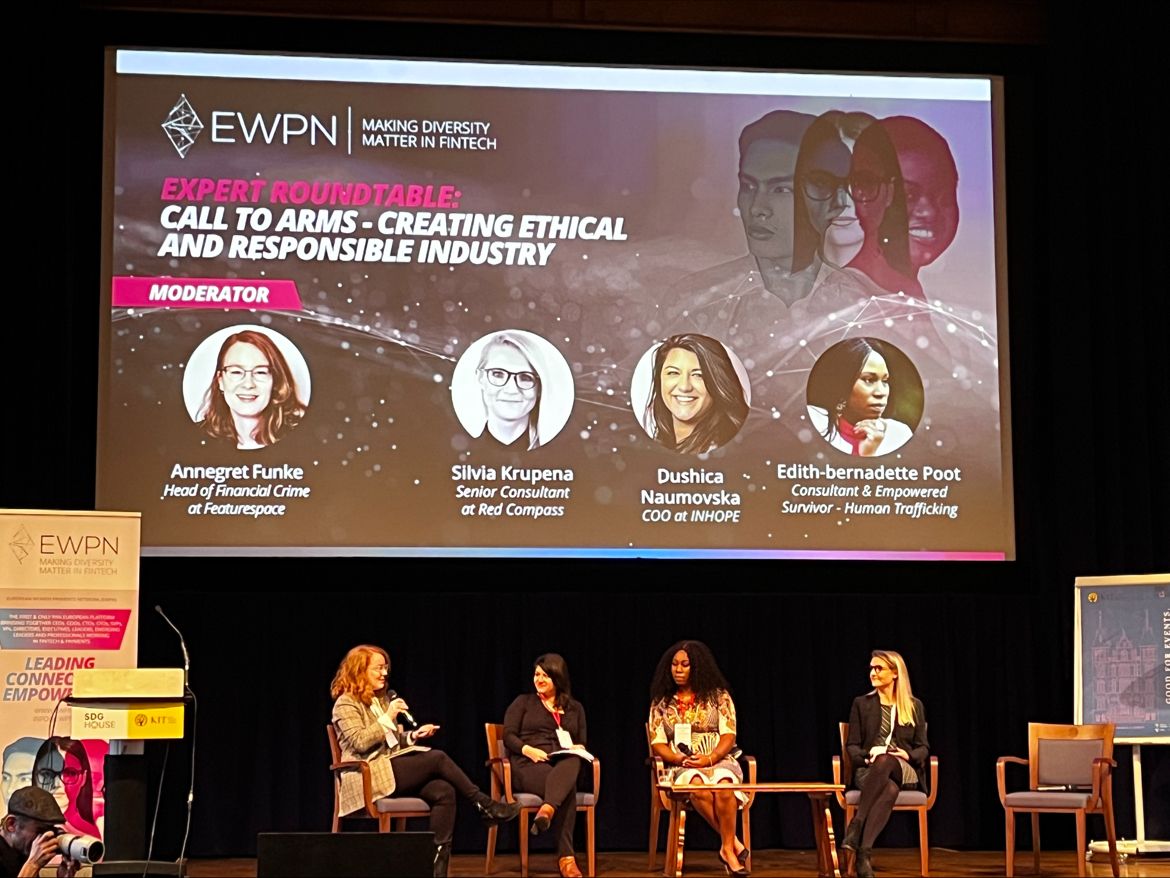A Call to Arms – Creating an ethical and responsible financial services industry
I recently had the privilege to moderate a panel at the annual conference of the European Women Payments Network (EWPN), featuring three other experts in combatting human trafficking. During its 2019 annual conference EWPN introduced four action points, including mobilising the industry to act against modern day slavery, child sexual abuse, and human trafficking.
The panel really highlighted the need to tackle these issues at all stages of the criminal operation, from initial crisis point where victims need protection, all the way through to robust anti-money laundering (AML) controls to identify illegal funds in the global financial ecosystem.
Global experts in preventing human trafficking
This panel of experts included those from outside of the payments industry, who bring valuable insights into how those of us who work in financial services can collaborate with technology companies, charities, law enforcement, government, and survivors to combat these crimes more swiftly and effectively:
Edith-Bernadette Poot is an empowered survivor of human trafficking, who provides consultancy to organisations looking to learn from the lived experiences of victims, so that they can better prevent human crimes at the point of crisis and improve support for survivors.
Dushica Naumovska and the INHOPE organisation works to combat the dissemination of Child Sexual Abuse Material (CSAM) online and integrate into global hotlines to better protect victims.
Silvija Krupena works to accelerate the application of modern slavery and human trafficking red flags into financial crime prevention teams and systems from RedCompass Labs’ open-access model.
At Featurespace, I work to ensure that financial crime prevention systems can action these red flags and other insights to accurately halt the flow of funds to organised criminal networks, as well as to effectively report suspicious activity to law enforcement.
Between us, we represent several links in the complex chain of events that we must consider if we are to effectively combat human trafficking. In this article, we are going to examine this chain for weak links and identify where we, as a payments community, can do better.
Creating conscious awareness of human trafficking
Step one, in cutting off criminal revenues from human trafficking, is working to raise awareness of the issue across the entire financial institution (FI). Edith-Bernadette always advises organisations to make human trafficking a continuous conversation within their employees, not just a one-off training.
“The difference between raising awareness and creating conscious awareness, is ensuring your teams bring human trafficking awareness to their daily work,” explained Edith –Bernadette. “There is not enough understanding about the challenges that face victims once they escape their traffickers.”
“After I began to reclaim my life, I was left with significant personal debt. These debts had been forcibly created by my traffickers, but without the receipts or evidence for this, I was blacklisted by financial services providers. In order to clear the debt and regain access to financial services and products, I must take on more work and stress. Obviously, this puts survivors at risk of becoming vulnerable to traffickers again and creates a vicious circle which is incredibly difficult to break.”
Edith-Bernadette outlined some of the unconsidered hurdles that face survivors, including unfair debt and the impact on credit ratings, prejudice against large gaps in work history, and a lack of schooling. All of these make it an uphill struggle for survivors to rebuild their lives.
Achieving conscious awareness as an FI could take the shape of education programmes internally about supporting vulnerable people as they enter their survivor life stage, or even programmes focused on debt cancellations and reformatting credit risk ratings.
Scaling financial crime controls programmes to counter human trafficking
One of the biggest challenges facing the industry is the sheer scale of human trafficking, and the complexity at which it appears in payments and financial services. Dushica explained what the financial services community do to tackle CSAM in payments, and specifically within their AML programmes.
“There is a clear need for data sharing,” says Dushica. “Global standards for that data structure and sharing, especially in terms of crime reporting, is needed to overcome the differences in legal classifications between different jurisdictions. These structures need to be adaptable enough to react when typologies evolve.”
“When we look at financial services specifically, there are three large failings within systems that are creating opportunity for criminals:
- Poor performance in monitoring for transactions associated with extortion
- Lack of stringency in Know Your Customer (KYC) and onboarding checks by Fintechs
- Missing communication between sending and receiving banks to identify ‘clean’ money used in Peer to Peer (P2P) and Account to Account (A2A) payments
Online child sexual exploitation has become a global industry generating $20 billion in a year. Action is needed to restrict criminal access to financial systems, as well as combat the laundering of illicit funds.”
INHOPE organisation enables anyone to anonymously report illegal imagery and directly integrates into hotlines and other points of action such as law enforcement and hosting providers including social media companies. The speed of reporting, evaluation, and then action against the criminals associated with imagery is crucial in INHOPE’s success in combatting CSAM. Financial services as an industry needs to begin using human trafficking data signals for transaction monitoring more quickly. When it comes to human crimes, speed of action is critical if we are to successfully combat this global crisis.
Human trafficking typologies for transaction monitoring
When we consider how to prevent people and children from becoming the victims of human trafficking, we have to break the criminal model that generates illegal profit from this exploitation. Historically FIs have struggled to conduct research and systemically apply insights into human trafficking into their financial crime controls, but that is all about to change. Silvija explained how the RedCompass Labs’ Red Flag Accelerator came about to make this possible.
“Human trafficking is one of the most widespread crimes in the world, affecting over 50 million people and generating $150 billion profit in a year,” Silvija explained. “This money used to buy, sell, and abuse people is flowing through our banking systems. This money is processed by legitimate financial services through millions of ordinary-looking transactions, and traces of crimes are hidden in terabytes of data isolated in different systems. Manual investigations at this scale would cost an enormous amount of money and time. This is where technology can help.”
As people and as an industry, there is of course a strong desire to eradicate human trafficking and is included in multiple United Nations Sustainable Development Goals that are targeted for achievement by 2030. Instead, criminal enterprises and the exploitation of humans are on the rise. So why have we not been successful?
“RedCompass Labs is not the first organisation trying to do something about human trafficking,” continued Silvija. “A lot of good work has been and is being done; however, working independently runs the risk of slowing down the progress. We understood the need for the in-depth research required to create a library of typologies, as we work towards a faster time to impact.
The RedFlag Accelerator consolidates and enhances the work done by the Thomson Reuters Foundation, the Banks Alliance Against Trafficking, United Nations, Financial Action Task Force (FATF), Organization for Security and Co-operation in Europe (OSCE), Finance Against Slavery and Trafficking (FAST), academia, governments, Financial Intelligence Units (FIU), and non-governmental organisations (NGOs) worldwide.”
Through this work, RedCompass Labs has been able to do eliminate duplicate work that individual FIs were undertaking to understand the human trafficking risks prevalent in their clients, products, and channels. There are hundreds of potential typologies that criminals use, and more than twenty predicate crimes that FIs must consider to systemically integrate anti-human trafficking insights into AML programmes.
Human trafficking red flags
As a first step, FIs need to conduct a risk assessment and better understand their exposure. “You need a structured approach to anti-human trafficking within a bank if you want to operationalise it into AML programmes,” continues Silvija. “Classifying transactions and attaching categories must be consistent whether you apply these in an automatic or ad-hoc way.”
It is critical to recognise that human trafficking may fall outside of your current fraud or AML ruleset. It may show up as lesser amounts or from unrestricted countries.
“We saw a case where multiple low value payments, between ten and fifty pounds, were made over a few hours, from a UK account to a Philippines account, late at night. These payments were made to access streaming of illegal content depicting CSAM. This payment pattern is not something that would typically be scrutinised because it is not a high value transaction, so it is not of note for fraud prevention systems,” explained Dushica.
Silvija highlighted that, “To significantly disrupt human trafficking and modern slavery, banks leverage libraries of insight in combination with automated processes, due diligence, red flags, and extra controls within systems. The eventual decisions on customers and transactions will be down to the individual risks within an organisation, but this approach can accelerate the search for suspicious activity and money coming from the trade of human beings”
Effective AML programmes against human trafficking
The need for speed of action is clear when we consider the awful reality for fifty million people around the world. As an industry we now have the combination of technology and actionable intelligence, joined up to get proactive on combatting human trafficking.
During his keynote, Gijs Boudewijn, Director of the Dutch Payments Association, referenced the recent report from the Coordination Center for Human Trafficking (CoMensha) on the European Day Against Human Trafficking, which found that despite decreasing reported cases of human trafficking, Netherlands is amongst the worst nations for human trafficking. Gijs noted that FIs are spending on AML programmes, but that this may be overly focused on compliance and not proactive prevention.
FIs have invested heavily to put AML systems and controls in place, but they are not yet using those effectively in order to combat human trafficking. The good news is that they can be better used. Insights and actionable intelligence consumable by machine learning models can make more accurate decisions on suspicious patterns, and even identify new typologies. Human trafficking detection has historically been seen as slow, manual, and costly, due to the complex natures of the crimes and routes of exploitation. Organisations have been worried that this could be another source of scenarios and rules that will be difficult to manage, tune, and potentially produce more false positives than productive outcomes. This is where we can leverage the AML tools we have already invested in, to do the heavy lifting: real-time and AI-based transaction monitoring can proactively look at hundreds of signals – such as the indicators compiled by RedCompass Labs – in the context of all other information known about the customers or counterparties. This means more accurate identification of funds related to human crimes, whilst reducing operational costs. Following investigations, data is fed into Suspicious Activity Report (SARs) filings to allow law enforcement to act against criminal organisations.
Lessons on ethics and responsibility in financial services
The experts outlined their hopes for payments professionals in terms of actions within organisations to improve payments and financial services efforts to combat human trafficking.
Edith-Bernadette
“Consult with – and learn from – empowered survivors, value their input, and leverage it in your programmes. Invest in educating your employees about human trafficking and modern slavery, so that they become consciously aware. You will see a return on this investment in the intelligence and insight your teams bring back to the business.”
Silvija
“Be intelligence–led and context-driven: make use of open access information that can accelerate your journey to protecting people, draw from existing examples that have been proven to work – don’t reinvent the wheel! Spend your time on what you are best at and identify and investigate using shared resources. And close the loop by providing good quality data to law enforcement, to improve prosecution success rates. Our ideal outcome is to catch the bad guys today, and to cut off the opportunity for criminals to abuse the financial and payment systems in the future.”
Dushica
“We need to form community with law enforcement, financial services, and civil society organisations to collaborate on identifying patterns and making good reports that lead to us eradicating human trafficking and CSAM. This requires the financial services industry and data protection authorities to work together to support the necessary data sharing that will protect people and victims. We are working on a global standard for policies and procedures to support this collaboration.”
I would like to see Featurespace’s mission become a reality: making the world a safer place to transact. In transaction monitoring we have two opportunities to identify crime: both criminal entities and the laundering of illicit proceeds. To achieve this we need to think about bringing together shared information. We also need to consider how we remove the old bias that is institutionalised and inherent in data tags and decisions to make space for the lived experiences of survivors, and insights from the front-line. The right intelligence exists, FIs just need to leverage it and make it part of systems now. We need faster action.
We must all confront the reality that is the horror of human trafficking,and accept the responsibility to actively seek opportunities to proactively combat it.
Share






